Welcome to the Active Wild list of dinosaurs. This page contains a list of dinosaurs names with pictures and information. Here you can learn about the many different kinds of dinosaur that existed in the Mesozoic Era.
Designed to be an "online dinosaur museum", it's a great place to start if you want to find out more about a particular dinosaur.
- You can find out more about dinosaurs on this page: Dinosaur Facts
- You can find out about the time periods of the Mesozoic Era ("The Age of Reptiles") on this page: Dinosaur Periods
Find out more about each period on these pages:
Want to see more dinos? If you're interested in seeing dinosaurs from specific periods, check out the following pages:
- Triassic Dinosaurs List with Pictures & Facts
- Jurassic Dinosaurs List with Pictures & Facts
- Cretaceous Dinosaurs List with Pictures & Facts
List of Dinosaurs: Dinosaur Names with Pictures
Below you’ll find a list of dinosaurs with pictures and information. You can follow links in the text to find out more about certain species.
This list includes all of the most famous dinosaurs together with many lesser-known species. How many dinosaurs on the list had you heard of? Have we missed any interesting dinos out? What's your favorite dinosaur?
Let us know in the comments section at the bottom of the page!
Abelisaurus

- Type of dinosaur: Theropod
- Period: Late Cretaceous
- Where found: Argentina
- Length: Approximately 7-9 meters (23-30 feet)
We start our list of dinosaurs with Abelisaurus, a predatory theropod dinosaur of the late Cretaceous Period. Abelisaurus was a medium-sized, bipedal* dinosaur that was probably between 7 and 9 metres (23 and 29 ft.) in length.
* An animal is said to be 'bipedal' if it walks on two legs.
Everything that we know about Abelisaurus comes from a single, incomplete skull! From this fossil scientists have been able to deduce the dinosaur's likely lifestyle, diet and size.
Being able to piece together a picture of how dinosaurs lived from the limited clues available to us is an important part of paleontology. (Paleontology, or palaeontology in British English, is the scientific study of prehistoric life. )
- Find out more about abelisaurus here: Abelisaurus Facts.
Acrocanthosaurus

- Type of dinosaur: Theropod
- Period: Early Cretaceous (around 110 million years ago)
- Where found: North America (especially in parts of Oklahoma, Texas, and Wyoming)
- Length: Up to 38 feet (11.5 meters)
One of the apex predators of its time, Acrocanthosaurus was known for the distinctive ridge or spine running along its back. This ridge, which is believed to have supported a hump or fin, might have had various roles, from fat storage to thermoregulation or display. Its robust and strong jaws, coupled with sharp teeth, made it a formidable predator, feasting on herbivorous dinosaurs.
Albertosaurus
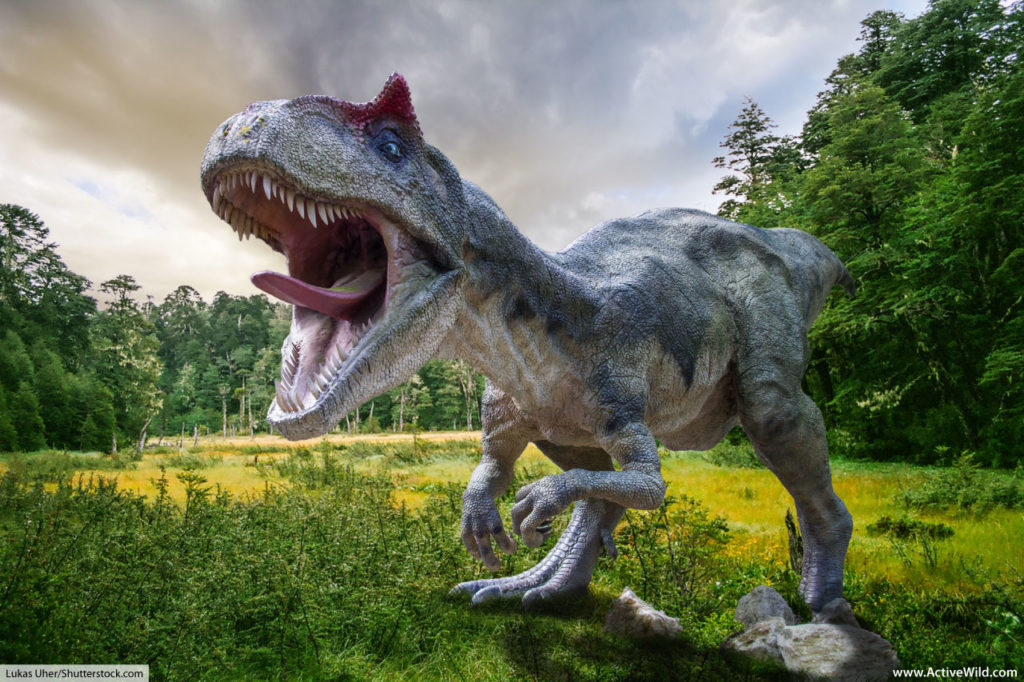
- Type of dinosaur: Theropod, closely related to T. rex
- Period: Late Cretaceous
- Where found: Western North America, primarily Alberta, Canada
- Length: Approximately 9 meters (30 feet)
Albertosaurus was a close relation of Tyrannosaurus, and was in the same family, Tyrannosauridae. Looking very much like its more famous relative, Albertosaurus walked on two legs, and had small arms. It would have been a fast runner, and probably sat at the very top of the food chain.
Albertosaurus had crests above its eyes which may have been brightly coloured. Unlike Tyrannosaurus, whose eyes pointed forwards, its eyes were on the sides of its head.
- You can read more about albertosaurus here: Albertosaurus Facts
Allosaurus
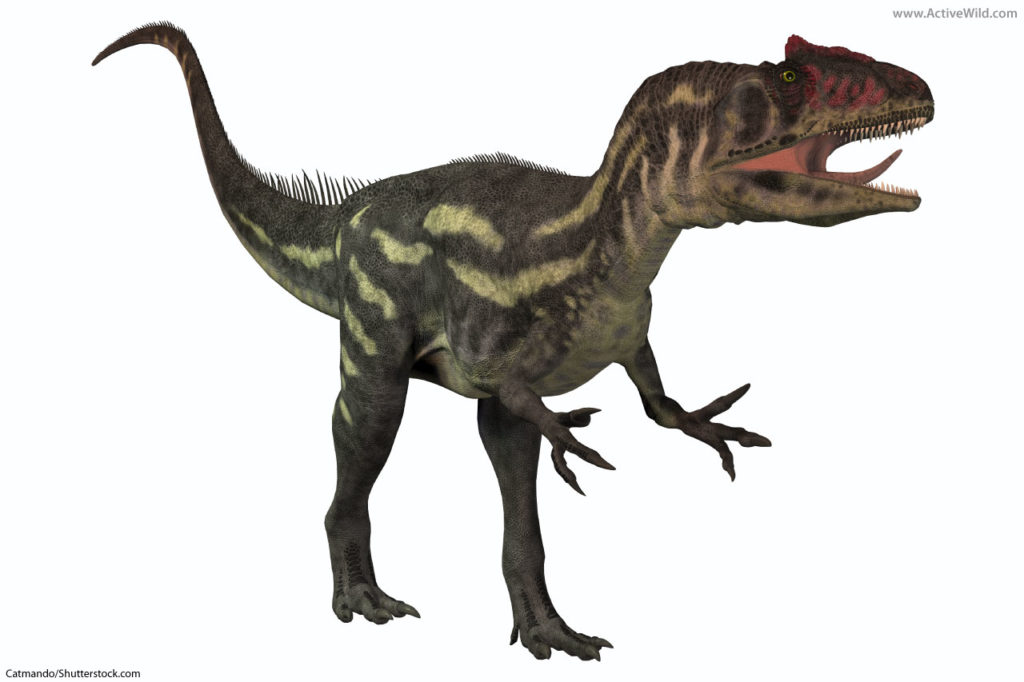
Allosaurus was a large carnivorous dinosaur from the Jurassic period. Click the picture to find out more!
- Type of dinosaur: Theropod
- Period: Late Jurassic
- Where found: North America, Europe, and possibly Africa
- Length: Around 8.5-12 meters (28-39 feet), though there's some variation depending on the species
Allosaurus was one of the largest predators of the Jurassic Period. It would have reached lengths of around 12 metres (40 ft.), and weighed between 2 and 5 metric tonnes (2.2 and 3.3 short tons).
Allosaurus preyed on dinosaurs such as Stegosaurus, and may even have hunted huge Jurassic Sauropods such as Diplodocus and Apatosaurus.
- You can find out more about allosaurus here: Allosaurus Facts
Amargasaurus
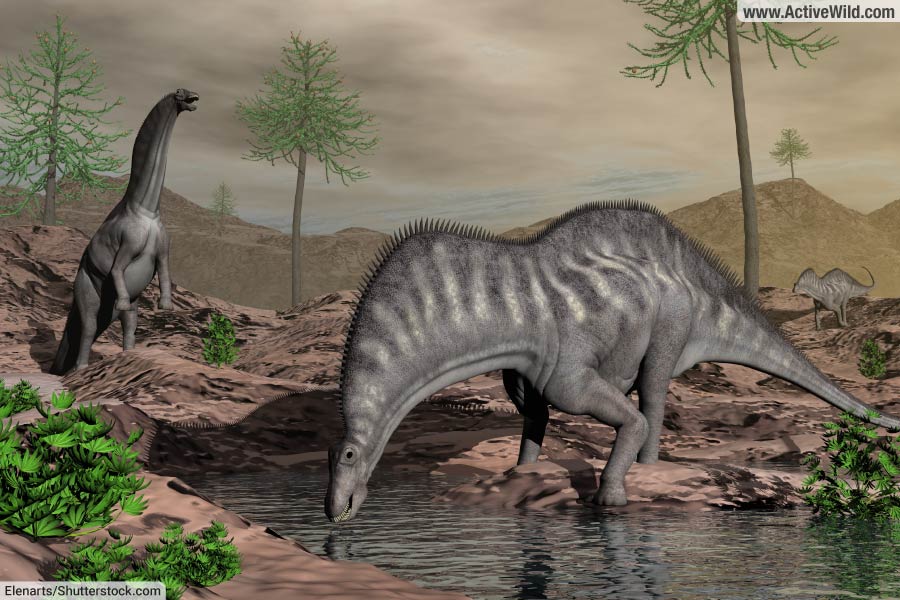
- Type of dinosaur: Sauropod
- Period: Early Cretaceous (around 125 million years ago)
- Where found: Argentina
- Length: About 33 feet (10 meters)
Amargasaurus stands out among sauropods due to its double row of long, upward-extending spines on its neck and back. Though their exact function is unknown, they might have supported skin sails for display, thermoregulation, or even protection. As a sauropod, it had a long neck and tail, with a relatively small head.
Ankylosaurus
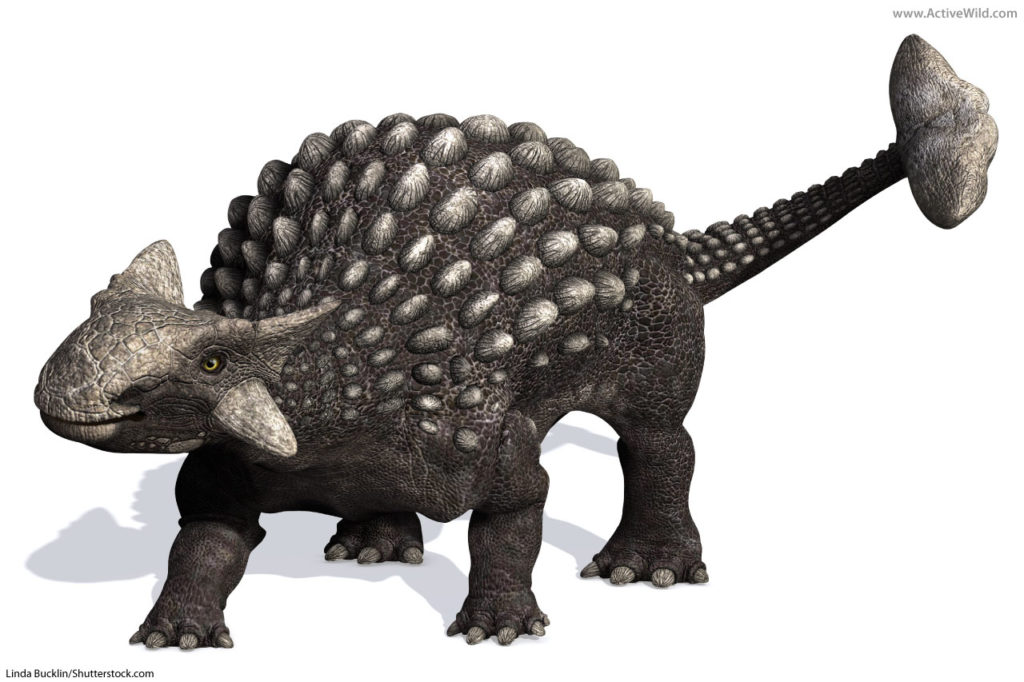
- Type of dinosaur: Armored herbivore
- Period: Late Cretaceous
- Where found: North America
- Length: Around 6-8 meters (20-26 feet)
Ankylosaurus was a member of a group of dinosaurs called Ankylosauria. Their name means ‘fused together lizards’ on behalf of their joined-together armoured plates.
Ankylosaurians were members of a larger group of dinosaurs called Thyreophora, otherwise known as the 'shield-bearers', or 'armored dinosaurs'. This group also included Stegosaurians such as stegosaurus.
Ankylosaurus was around 10 metres (33 ft.) in length and weighed around 5 metric tonnes (5.5 short tons). It had a bony club at the end of its powerful tail. This would have been an effective weapon against predators.
- Find out more about ankylosaurus here: Ankylosaurus Facts.
Apatosaurus
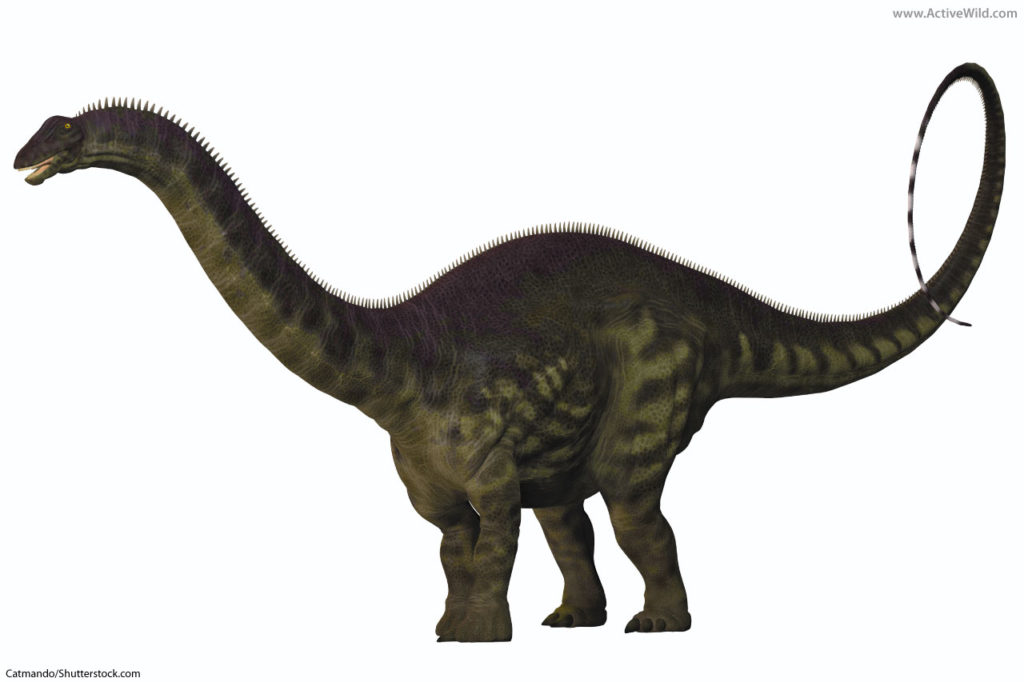
- Type of dinosaur: Sauropod
- Period: Late Jurassic
- Where found: North America
- Length: Approximately 21-22 meters (70-72 feet)
Apatosaurus was a huge sauropod dinosaur. It lived in the late Jurassic Period. It weighed between 20 and 30 metric tonnes (22 and 33 short tons), and was around 20 to 23 metres (65 and 75 ft.) in length.
Apatosaurus achieved its colossal size by eating plants rather than meat. It may have used its long tail as a whip to protect itself from predators.
Brontosaurus was discovered after Apatosaurus. At the time it was thought to be a different dinosaur, but it was later found to be an Apatosaurus. However, the name 'Brontosaurus' had become so widely-used that many people still think that they are different dinosaurs.
There’s a twist in the tail: recent studies have found that the Brontosaurus may not be an Apatosaurus after all!
- You can find out more about apatosaurus here: Apatosaurus Facts
Archaeopteryx

- Type of dinosaur: Transitional fossil between non-avian dinosaurs and birds
- Period: Late Jurassic
- Where found: Southern Germany
- Length: About 0.5 meters (1.6 feet) including the tail
If you can imagine a cross between a small dinosaur and a bird, then you'll probably have a good idea of what Archaeopteryx looked like. It had the tooth-filled mouth and bony tail of a dinosaur, with the feathered wings of a bird. It may even have been able to fly, rather than simply glide.
Archaeopteryx lived in the late Jurassic Period. Animals like archaeopteryx (but possibly not archaeopteryx itself) were the ancestors of all today's birds. Many scientists now consider birds to be dinosaurs!
- Read more about Archaeopteryx here: Archaeopteryx Facts
Argentinosaurus
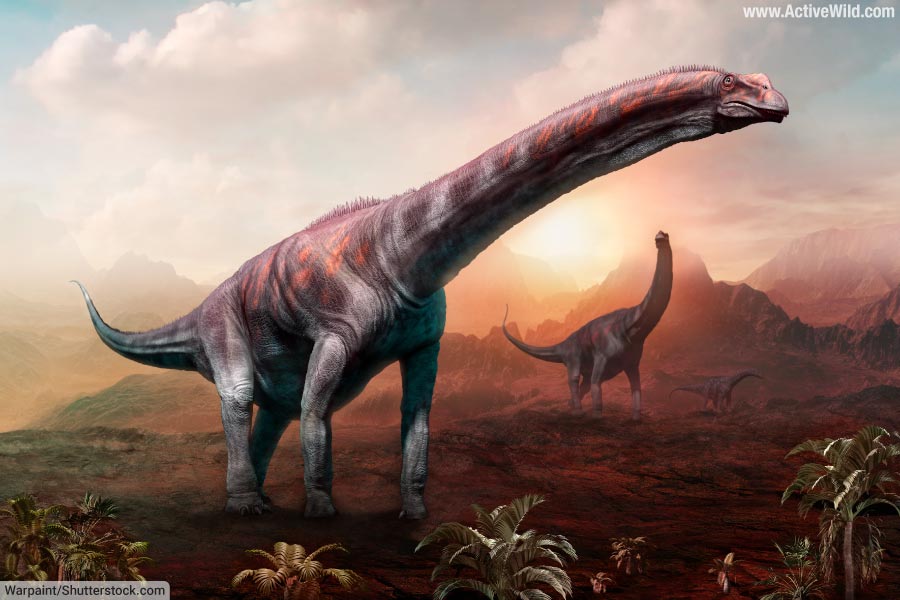
- Type of dinosaur: Sauropod
- Period: Late Cretaceous (around 94-97 million years ago)
- Where found: Argentina
- Length: Estimates range up to 100 feet (30 meters)
Among the largest land animals ever to have lived, Argentinosaurus is known from limited fossils, but its immense size is undisputed. It had a massive body, long neck, and tail, and would have moved at a slow pace, browsing on vast amounts of vegetation with its small head.
Baryonyx

- Type of dinosaur: Theropod, spinosaurid
- Period: Early Cretaceous
- Where found: England, Spain
- Length: Approximately 7.5-10 meters (25-33 feet)
Baryonyx was a bipedal, fish-eating dinosaur that lived in the early Cretaceous Period. Its narrow, tooth-filled snout is thought to have been similar to that of today's gharial – a fish-eating crocodilian found in Asia.
In 1983, amateur fossil collector William J. Walker came across a strange fossil. He alerted the Natural History Museum in London, who realised that he had made an important find.
After further digging, palaeontologists uncovered around three-quarters of a new dinosaur. It was named Baryonyx walkeri, in honour of its discoverer.
- Find out more about Baryonyx here: Baryonyx Facts
Brachiosaurus

- Type of dinosaur: Sauropod
- Period: Late Jurassic
- Where found: North America, Africa
- Length: About 18-26 meters (59-85 feet)
This huge sauropod grew up to 25 metres (82 ft.) in length and weighed between 30 and 50 metric tonnes (33 and 55 short tons). It was one of the largest land animals ever. Brachiosaurus’s name means ‘arm lizard’, because of the way its forelimbs joined its shoulders.
Unlike other sauropods, Brachiosaurus’s front legs were longer than its hind legs.
- You can find out more about Brachiosaurus here: Brachiosaurus Facts.
Brontosaurus
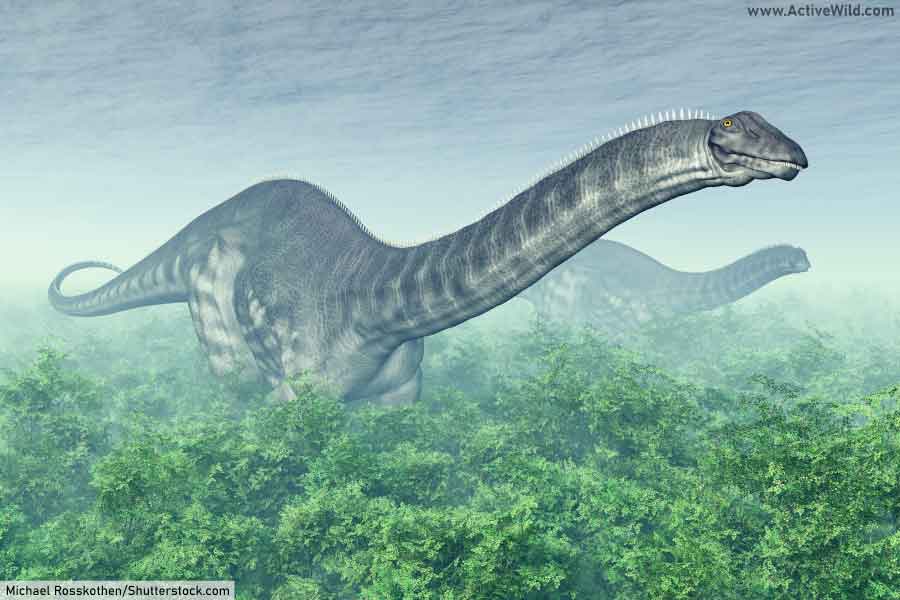
- Type of dinosaur: Sauropod
- Period: Late Jurassic (around 155 to 152 million years ago)
- Where found: North America (mainly in the Morrison Formation of the western U.S.)
- Length: Up to 72 feet (22 meters)
Brontosaurus, which means "thunder lizard", is one of the most iconic and recognizable dinosaurs due to its massive size, long neck, and lengthy tail.
For a long time, Brontosaurus was considered a misclassification and was grouped under Apatosaurus. However, in 2015, a comprehensive study re-established Brontosaurus as a distinct genus.
These gentle giants were herbivores, using their long necks to feed on plants high above the ground as well as lower vegetation. Their massive body was supported by four stout, pillar-like legs. Despite their enormous size, their brains were relatively small.
Brontosaurus, like other sauropods, probably traveled in herds and used their sheer size as a primary defense against predators.
You can find out more about Brontosaurus on this page: Brontosaurus Facts.
Carnotaurus

- Type of dinosaur: Theropod
- Period: Late Cretaceous
- Where found: Argentina
- Length: Around 7.5-9 meters (25-30 feet)
Carnotaurus was a large, fast-moving predator that walked on two legs. It was around 9 metres (30 ft.) in length, and weighed around 1.35 metric tonnes (1.5 short tons).
This distinctive meat-eater had two horns on its head. Its name means ‘meat-eating bull’ on behalf of these bull-like horns.
- Find out more about Carnotaurus here: Carnotaurus Facts.
Ceratosaurus
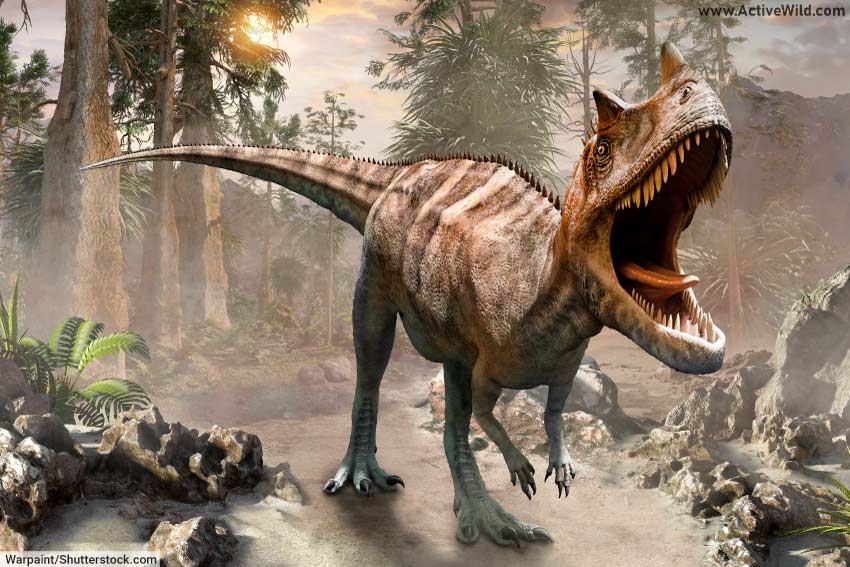
- Type of dinosaur: Theropod
- Period: Late Jurassic (around 150 million years ago)
- Where found: North America and possibly Portugal
- Length: About 18-20 feet (5.5-6 meters)
Distinguished by its large nasal horn and two smaller horns in front of its eyes, Ceratosaurus was a carnivore with sharp teeth and a long tail. It had a more slender build compared to other large theropods of its time, suggesting it might have had a different ecological niche.
You can find out more about Ceratosaurus on this page: Ceratosaurus Facts
Chasmosaurus
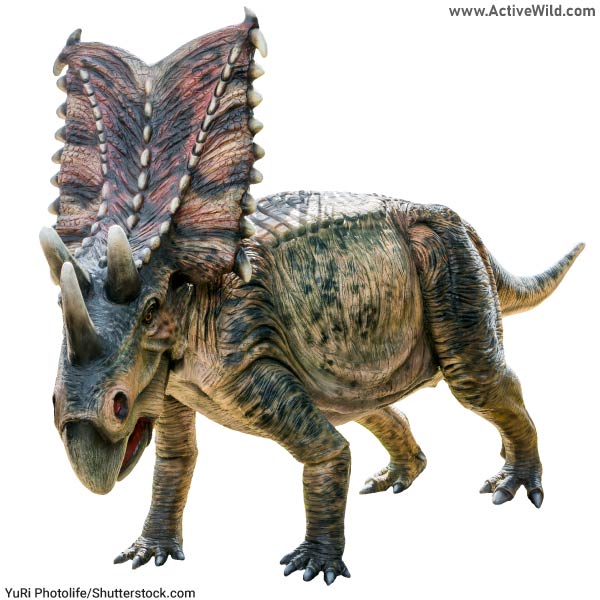
- Type of dinosaur: Ceratopsian
- Period: Late Cretaceous (around 75-76 million years ago)
- Where found: North America (Canada)
- Length: Up to 16 feet (4.8 meters)
Chasmosaurus was a four-legged herbivore with a large, ornate frill and long brow horns. Its frill was adorned with large fenestrae or holes, and it was likely used in display or defense. As a ceratopsian, it would have had a beak-like mouth for cropping vegetation.
Coelophysis
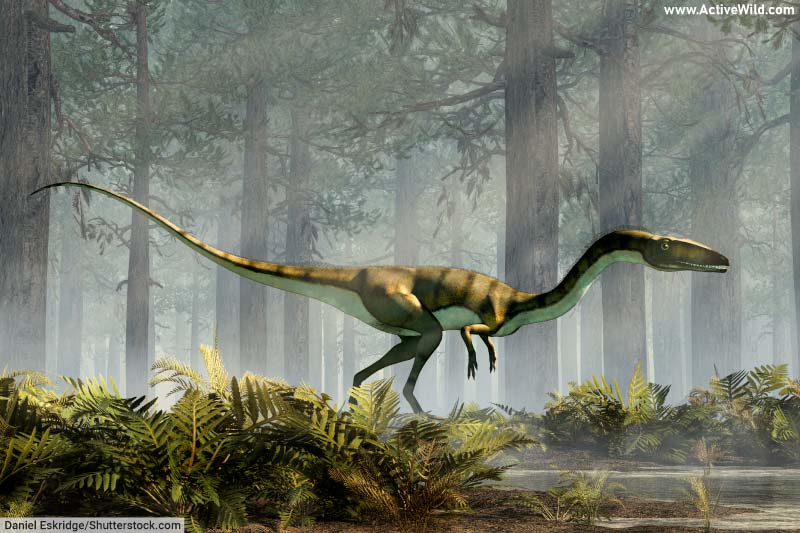
- Type of dinosaur: Theropod
- Period: Late Triassic
- Where found: Southwestern United States, especially New Mexico
- Length: Approximately 3 meters (10 feet)
Coelophysis is one of the earliest known dinosaurs. It lived in the late Triassic Period. Despite their great age, many Coelophysis fossils have been found.
Coelophysis was a small and lightly-built dinosaur. It would have been nimble and fast, and may have hunted in packs.
Compsognathus
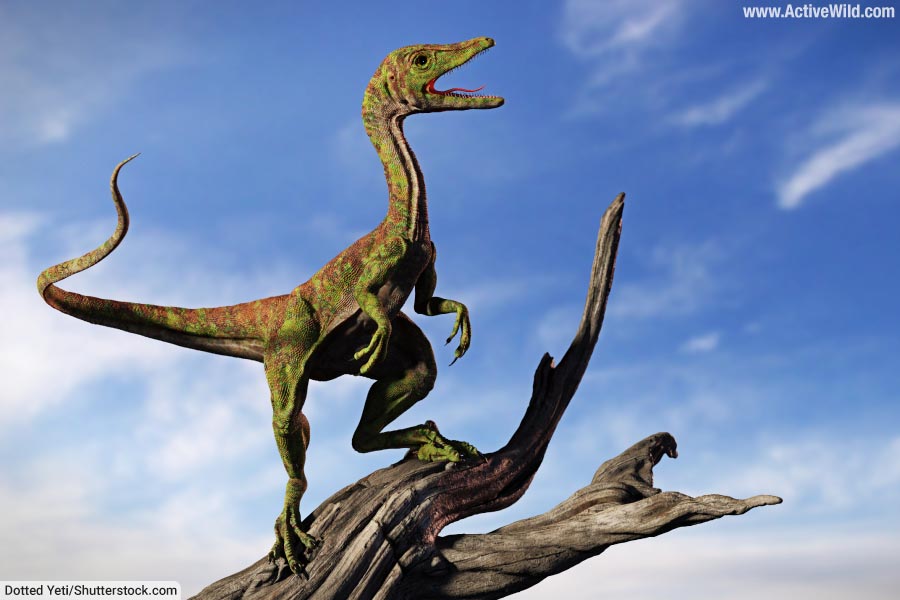
- Type of dinosaur: Theropod
- Period: Late Jurassic
- Where found: Germany and France
- Length: About 1 meter (3.3 feet)
At the time of writing, only two Compsognathus specimens have been discovered. The first was found in Germany in the mid-nineteenth century. The second was found in France over 100 years later, in 1971.
Compsognathus lived during the late Jurassic period.
This bird-like bipedal predator was famous for many years for being one of the smallest dinosaurs. Since the end of the twentieth century, however, several smaller dinosaurs have been discovered.
Deinonychus
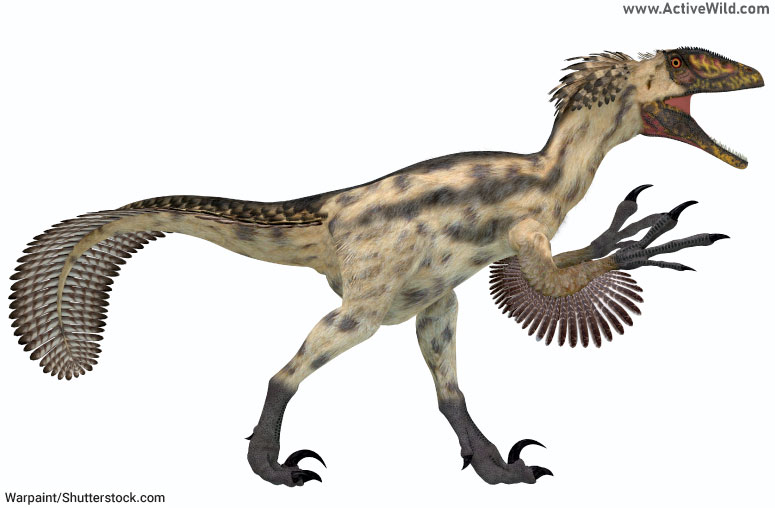
- Type of dinosaur: Theropod, dromaeosaurid
- Period: Early Cretaceous
- Where found: Western North America
- Length: Around 3.4 meters (11 feet)
This early Cretaceous dinosaur grew to around 3 metres (10 ft.) in length and weighed around 80 kg (176 lb). Its name, which means ‘terrible claw’, refers to the deadly claw found on each of its feet.
While small compared to other dinosaurs, Deinonychus was built for speed, and would have been an effective predator. It had long forelimbs and powerful clawed ‘hands’.
Dilophosaurus
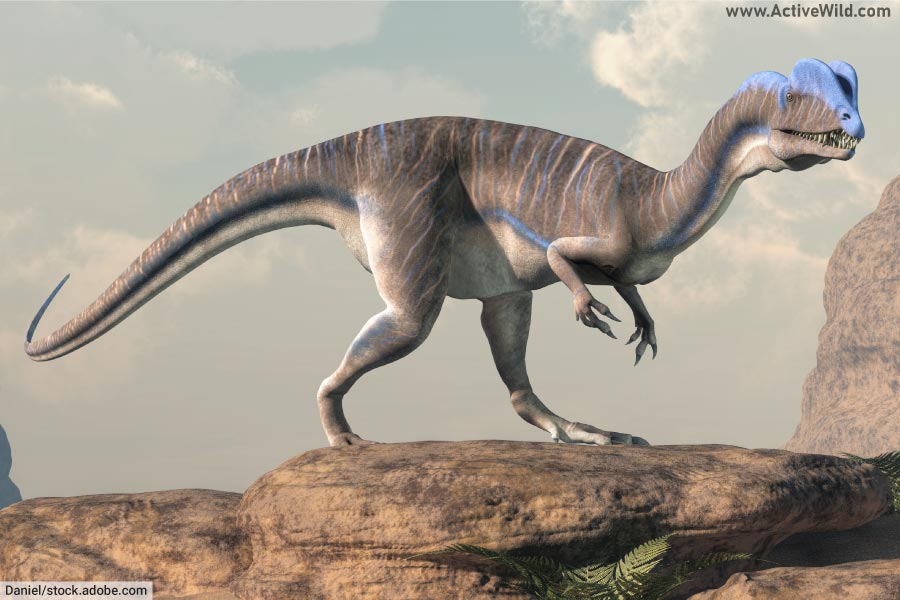
- Type of dinosaur: Theropod
- Period: Early Jurassic (around 193 million years ago)
- Where found: North America (Arizona)
- Length: About 20 feet (6 meters)
Notable for its twin crests on its skull, Dilophosaurus is an early theropod that was likely a fast and agile predator. While popular media depicted it spitting venom, there's no scientific evidence supporting this idea.
You can find out more about this dinosaur on this page: Dilophosaurus Facts
Diplodocus
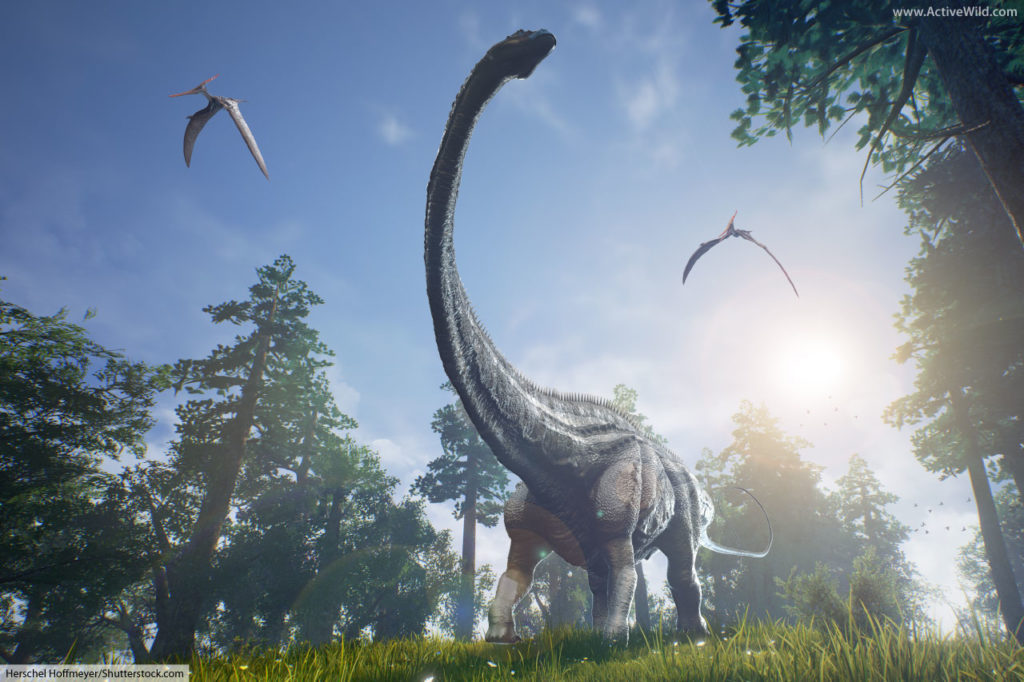
- Type of dinosaur: Sauropod
- Period: Late Jurassic
- Where found: North America
- Length: Around 25 meters (82 feet)
Diplodocus, like all other sauropods, was a giant, four-legged dinosaur with a long neck and tail. It may have used its long tail as a whip for protection against predators.
Diplodocus was around 25 metres (82 ft.) in length. It weighed between 10 and 26 metric tonnes (11 and 29 short tons). It lived in North America during the late Jurassic Period.
- Find out more about Diplodocus here: Diplodocus Facts.
Edmontosaurus
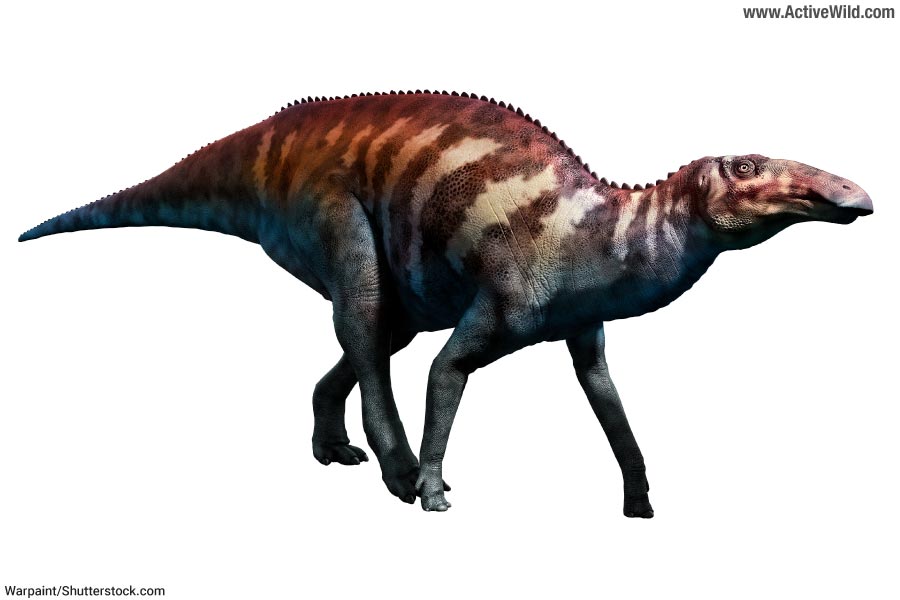
- Type of dinosaur: Hadrosaurid (duck-billed dinosaur)
- Period: Late Cretaceous
- Where found: North America
- Length: Approximately 9-12 meters (30-40 feet)
Edmontosaurus was a large herbivorous dinosaur. It was a member of the ‘duck-billed’ group of dinosaurs, so-called due to their duck-like mouths. Herds of edmontosaurus roamed western North America in the late Cretaceous Period.
Edmontosaurus would have walked on its longer hind legs for most of the time. By studying its teeth, paleontologists can tell it was a grazer. While grazing it would probably have walked on all four legs.
Gallimimus
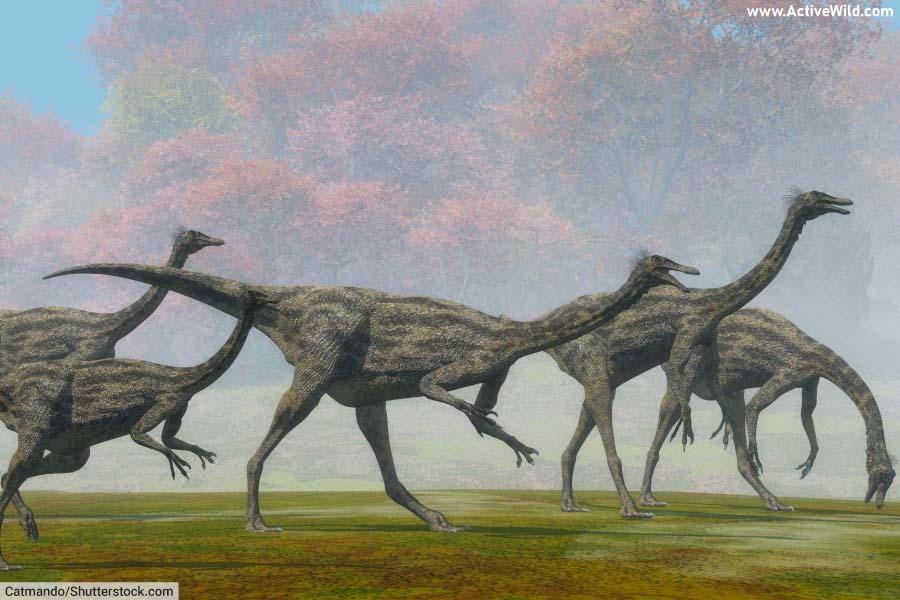
- Type of dinosaur: Ornithomimid
- Period: Late Cretaceous (around 70 million years ago)
- Where found: Mongolia
- Length: Up to 20 feet (6 meters)
Gallimimus, with its long legs and ostrich-like build, was built for speed. It had large eyes, a long neck, and a toothless beak. As an omnivore, it likely consumed a diet of plants, insects, and small animals.
You can find out more about Gallimimus on this page: Gallimimus Facts
Giganotosaurus

- Type of dinosaur: Theropod
- Period: Late Cretaceous
- Where found: Argentina
- Length: About 12-13 meters (40-43 feet)
Giganotosaurus means ‘giant southern lizard’. This giant predator walked on two legs and was even bigger than Tyrannosaurus.
Giganotosaurus was around 16 metres (62 ft.) in length and weighed 8 metric tonnes (9 short tons). It was likely to have had good senses of both sight and smell.
Giganotosaurus was found in South America during the late Cretaceous Period.
- You can find out more about Giganotosaurus here: Giganotosaurus Facts.
Gorgosaurus
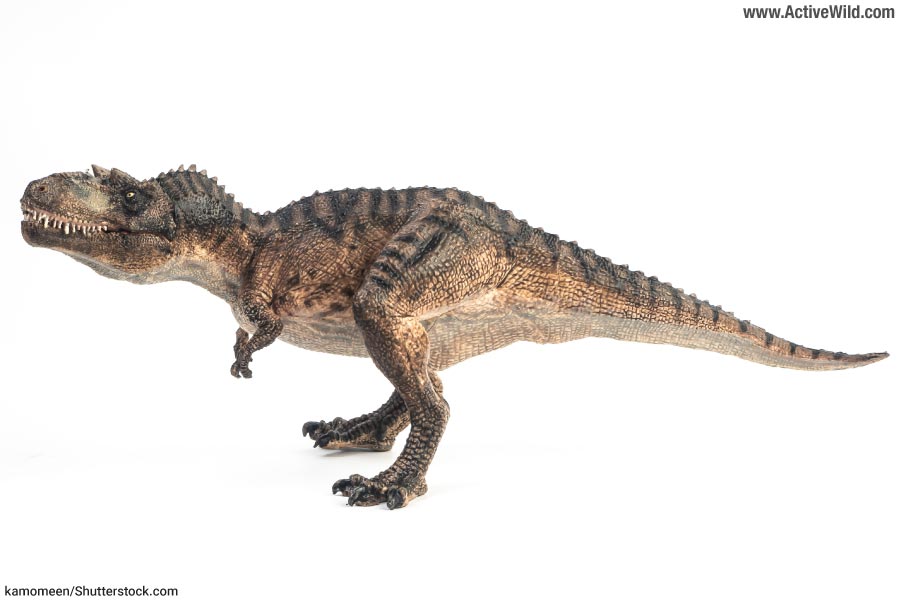
- Type of dinosaur: Theropod, tyrannosaurid
- Period: Late Cretaceous
- Where found: North America
- Length: Around 8-9 meters (26-30 feet)
With a huge skull and jaws filled with sharp teeth, Gorgosaurus definitely lived up to its name, which means ‘dreadful lizard’.
Gorgosaurus was a close relative of tyrannosaurus, being in the same family, Tyrannosauridae. Gorgosaurus lived in the late Cretaceous Period and was found in America and Canada.
- Find out more about Gorgosaurus here: Gorgosaurus Facts
Iguanodon
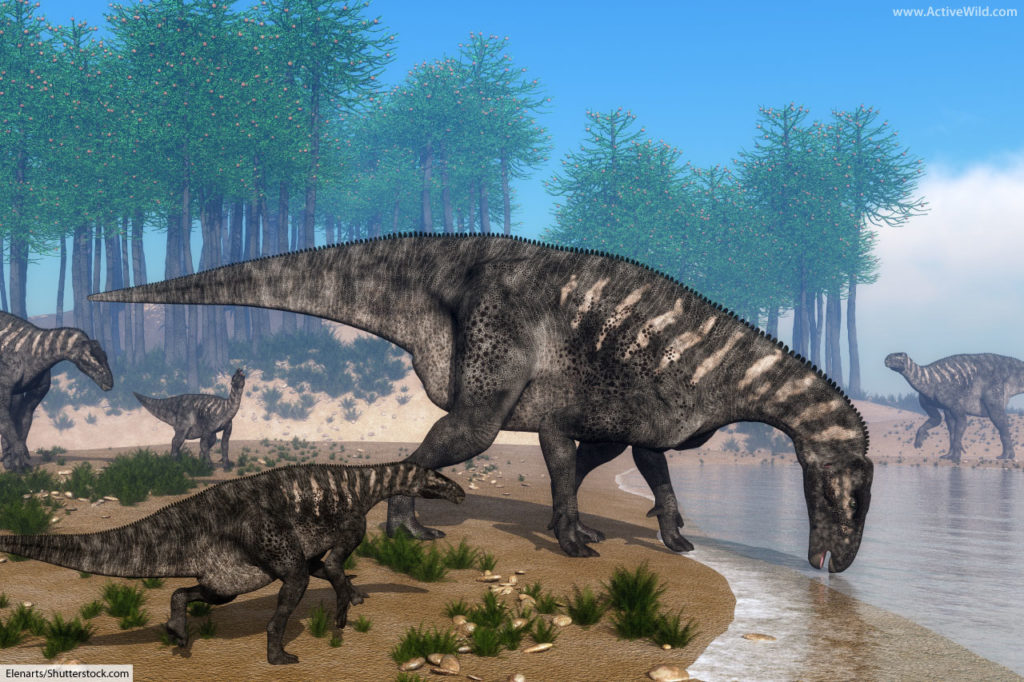
- Type of dinosaur: Ornithopod
- Period: Early Cretaceous
- Where found: Europe, primarily Belgium and UK, but also found in other parts of the world
- Length: About 10 meters (33 feet)
Iguanodon was the second dinosaur ever to be named. The first Iguanodon fossil was a tooth. It was discovered in England by the wife of medical doctor and geologist Dr Gideon Mantell. Mantell named the specimen Iguanodon, because the tooth resembled that of an iguana.
Iguanodon was a large, plant-eating dinosaur, able to walk on two and four legs. It lived in the early Cretaceous Period.
Iguanodon had spiked thumbs. These may have been used either as a means of defence against predators or for fighting with other Iguanodons.
- Find out more here: Iguanodon Facts
Leaellynasaura

- Type of dinosaur: Small ornithopod
- Period: Early Cretaceous
- Where found: Australia
- Length: Approximately 2 meters (6.5 feet)
This small bipedal dinosaur was just under 1 metre (3 ft.) in length. It was first discovered in the Australian dinosaur hotspot Dinosaur Cove.
Leaellynasaura lived in the early Cretaceous Period. It may have been fully-feathered.
Megalosaurus
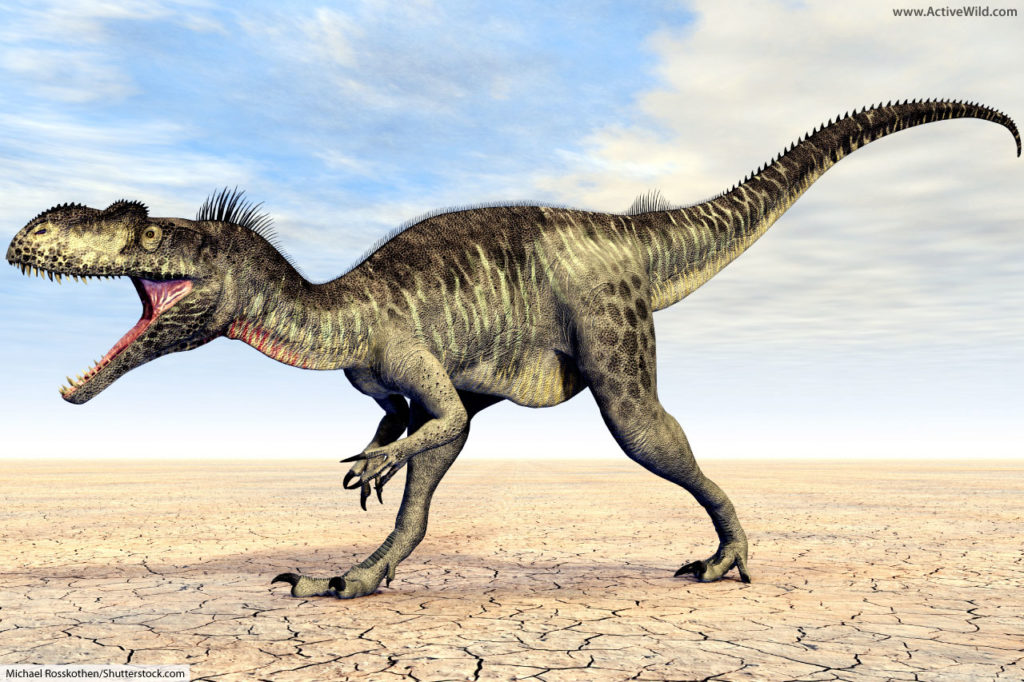
- Type of dinosaur: Theropod
- Period: Middle Jurassic
- Where found: England
- Length: Around 6 meters (20 feet)
Megalosaurus was discovered in England. It was the first dinosaur to be named. Surgeon and geologist James Parkinson identified some fossilised remains as being those of a reptile. He named it ‘Megalosaurus’, which means ‘great lizard’. This was in 1824: almost twenty years before Sir Richard Owen invented the word ‘dinosaur’!
Megalosaurus was around 9 metres (30 ft.) in length and weighed around 1 metric tonne (1.1 short tons). It stood on two legs, and was a predator. It lived in the middle Jurassic Period.
- You can find out more about Megalosaurus here: Megalosaurus Facts
Minmi

- Type of dinosaur: Armored herbivore, ankylosaurian
- Period: Early Cretaceous
- Where found: Australia
- Length: Approximately 3 meters (10 feet)
Minmi was a heavily armoured small dinosaur of the Ankylosauria family. Its body, including its undersides, was covered with bony plates. It had longer legs than most of its relatives, suggesting that, despite being heavily armoured, it could move quickly.
Minmi fossils have been discovered in Australia. It lived in the early Cretaceous Period.
Ornithomimus

- Type of dinosaur: Theropod, ornithomimid
- Period: Late Cretaceous
- Where found: North America
- Length: About 3.5-4 meters (11-13 feet)
Ornithomimus was an ostrich-like dinosaur. Around 3.5 metres (11.5 ft.) long, Ornithomimus had long legs and a long, thin neck. It would have been able to run at high speeds, possibly reaching over 40 mph (64 km/h).
Ornithomimus means ‘bird mimic’. It is so-named due to its bird-like feet. Fossils indicate that Ornithomimus had feathers.
Parasaurolophus
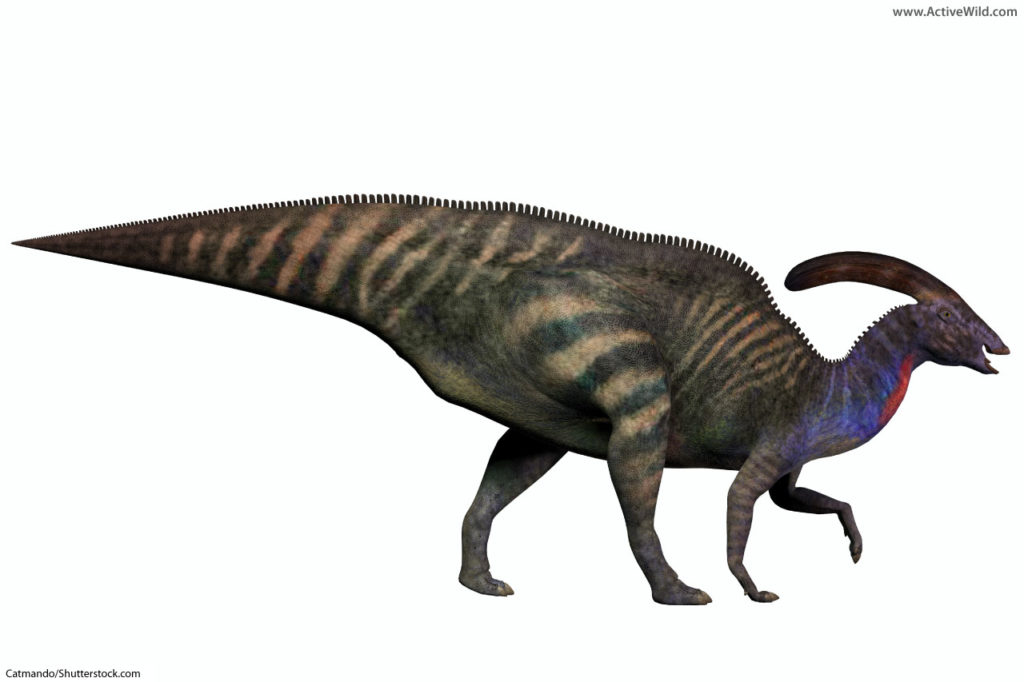
- Type of dinosaur: Hadrosaurid (duck-billed dinosaur)
- Period: Late Cretaceous
- Where found: North America
- Length: Around 9.5-10 meters (31-33 feet)
Parasaurolophus was a Late Cretaceous herbivore. It was around 10 metres (33 ft.) in length and weighed around 3.5 metric tonnes (4 short tons).
Parasaurolophus had a distinctive crest at the back of its head. Tubes inside of this crest were connected to its nostrils.Scientists speculate that this arrangement may have been used to produce sound.
Parasaurolophus had a tall but narrow tail. Males may have had brightly-colored tails in order to attract females.
- You can find out more about Parasaurolophus here: Parasaurolophus Facts.
Protoceratops

- Type of dinosaur: Herbivorous ceratopsian
- Period: Late Cretaceous
- Where found: Mongolia
- Length: About 1.8 meters (6 feet)
Protoceratops was a sheep-sized dinosaur of the late Cretaceous Period. It had jaws shaped like a parrot’s bill, and a mouthful of teeth for eating tough vegetation. A frill on the back of its head may have served to protect its neck.
In Mongolia, a fossilised protoceratops was found entwined with a fossilised velociraptor. The velociraptor may have been attacking the protoceratops before a land slip buried both animals.
Spinosaurus
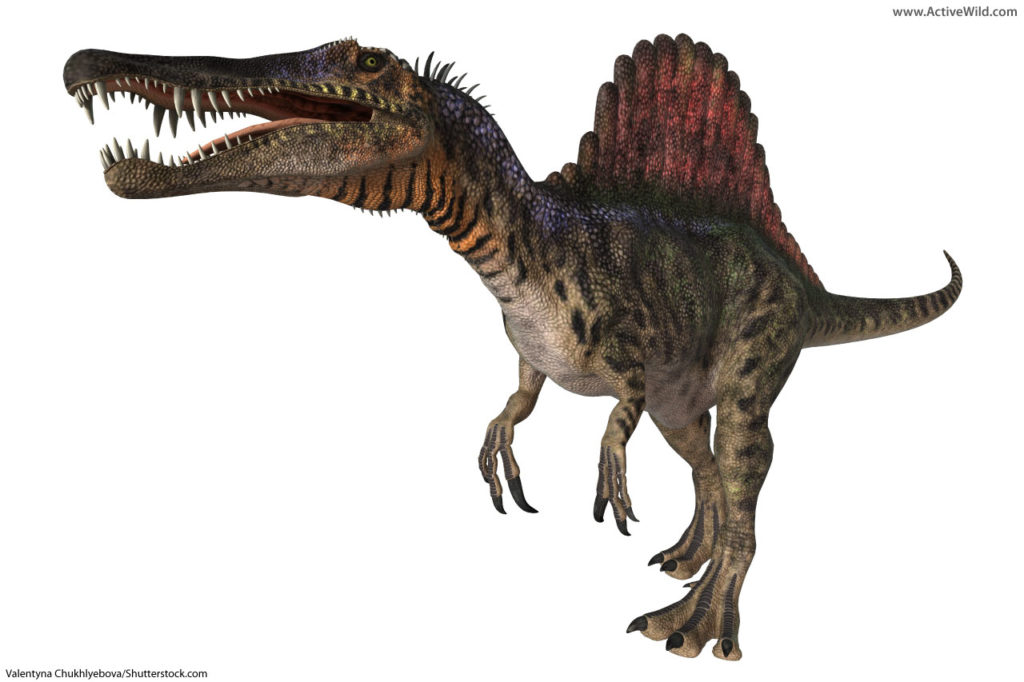
- Type of dinosaur: Theropod, spinosaurid
- Period: Early to mid-Cretaceous
- Where found: North Africa
- Length: Approximately 15-18 meters (49-59 feet), recent estimates suggest it might have been the largest of all known carnivorous dinosaurs
Spinosaurus was a meat-eating dinosaur of the late Cretaceous Period. Growing up to 15 metres (49 ft.) in length and 23 metric tonnes (25.35 short tons) in weight, it was larger than the mighty Tyrannosaurus Rex.
Spinosaurus was quite possibly the largest predator ever to have walked the earth.
Spinosaurus means ‘thorn lizard' or 'spine lizard’. The name comes from Spinosaurus’s most distinctive feature: a large ‘sail’ on its back, which consisted of spines covered by a layer of skin.
Scientists think that this bony sail helped spinosaurus to warm up faster than other dinosaurs, allowing it to hunt when others could not.
- You can find out more about Spinosaurus here: Spinosaurus Facts.
Stegoceras
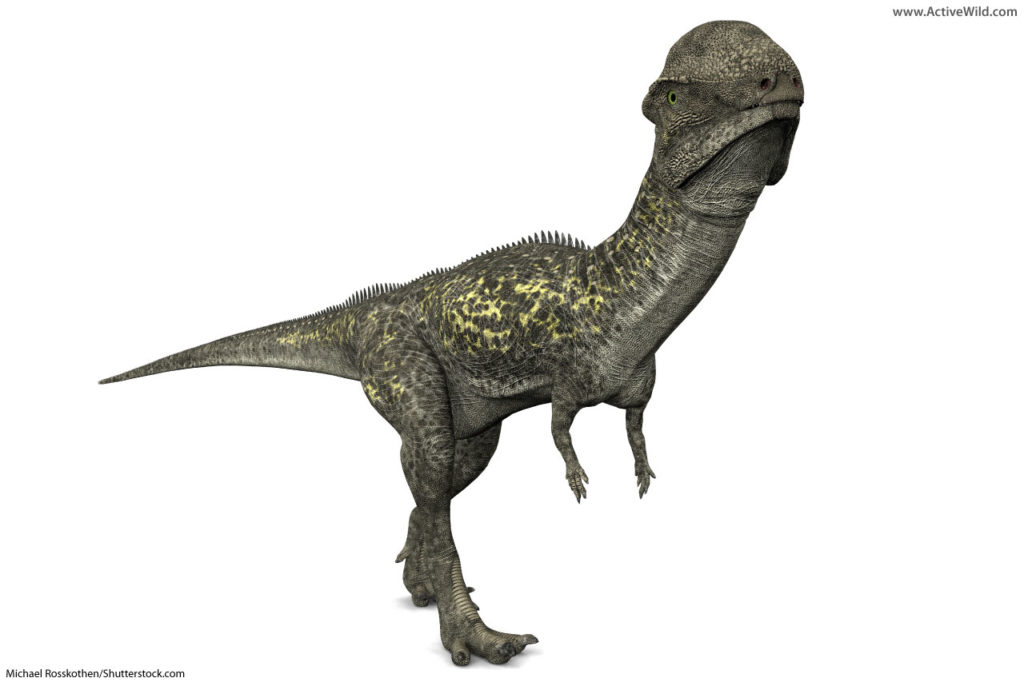
- Type of dinosaur: Pachycephalosaurid (dome-headed dinosaur)
- Period: Late Cretaceous
- Where found: North America
- Length: About 2 meters (6.5 feet)
Stegoceras was a bipedal herbivore that lived in North America during the late Cretaceous Period. It was around 2 metres (6.5 ft.) in length and stood around .75m (2.5 ft.) tall.
Stegoceras was a Pachycephalosaurian; a ‘dome-headed dinosaur’ with a very thick skull. It was probably a herd animal.
Stegosaurus
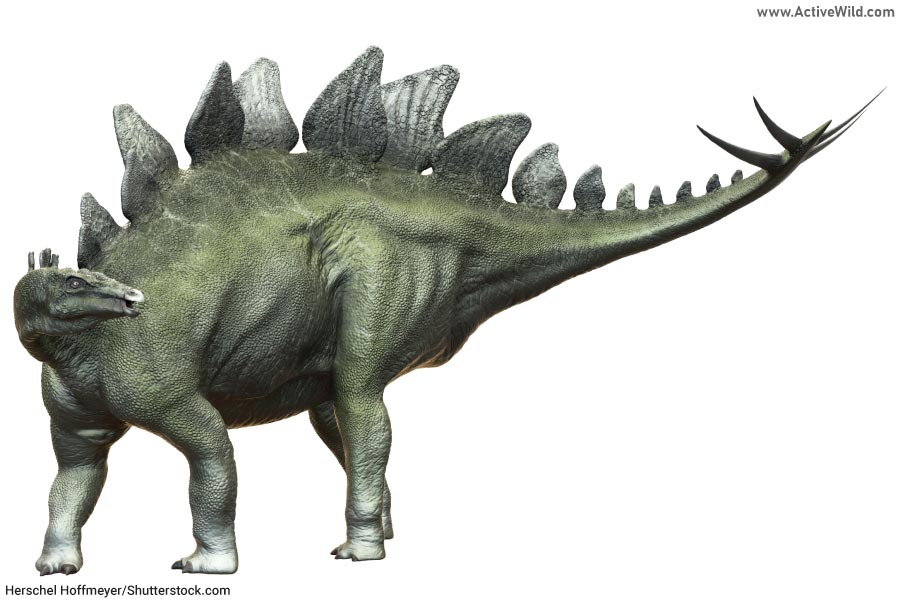
- Type of dinosaur: Armored dinosaur (Thyreophoran)
- Period: Late Jurassic
- Where found: North America and Europe
- Length: Around 9 meters (30 feet)
Stegosaurus was a large plant-eating dinosaur in the Stegosauridae family. It roamed America during the late Jurassic period.
Stegosaurus grew to around 9 metres (30 ft.) in length, and weighed around 2 metric tonnes (2.2 short tons). This large dinosaur was no rocket scientist; its brain was around the size of a walnut!
Stegosaurus had a row of large bony plates running along the top of its back. There are various explanations as to what the plates were for. Some scientists think that they offered protection from predators, others believe that they helped the animal stay at the correct temperature.
Stegosaurus was able to defend itself with a cluster of spikes on its tail.
- Find out more about Stegosaurus here: Stegosaurus Facts.
Suchomimus

- Type of dinosaur: Theropod, spinosaurid
- Period: Early Cretaceous
- Where found: Niger, Africa
- Length: About 11 meters (36 feet)
Suchomimus was a member of the Spinosauridae family of dinosaurs, and a relative of Spinosaurus.
Like Spinosaurus, Suchomimus had a spiny sail on its back and a long, crocodile-like face. It lived in Africa during the early Cretaceous Period.
Tarbosaurus
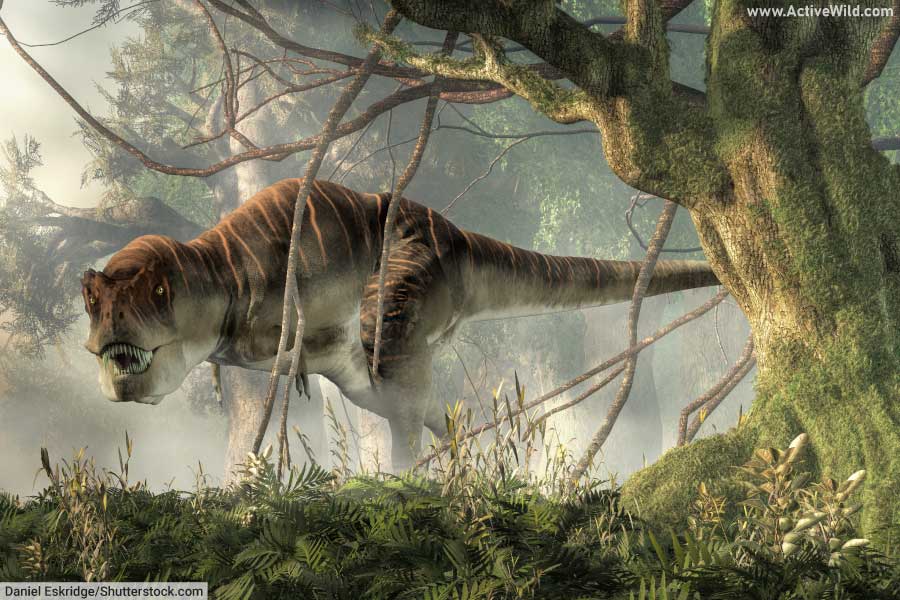
- Type of dinosaur: Theropod
- Period: Late Cretaceous (around 70 million years ago)
- Where found: Asia (especially Mongolia)
- Length: Up to 40 feet (12 meters)
A close relative of Tyrannosaurus Rex, Tarbosaurus was the apex predator in its ecosystem. It had powerful jaws, sharp teeth, and tiny, almost vestigial arms. Its massive head and strong legs made it a fearsome hunter.
Triceratops
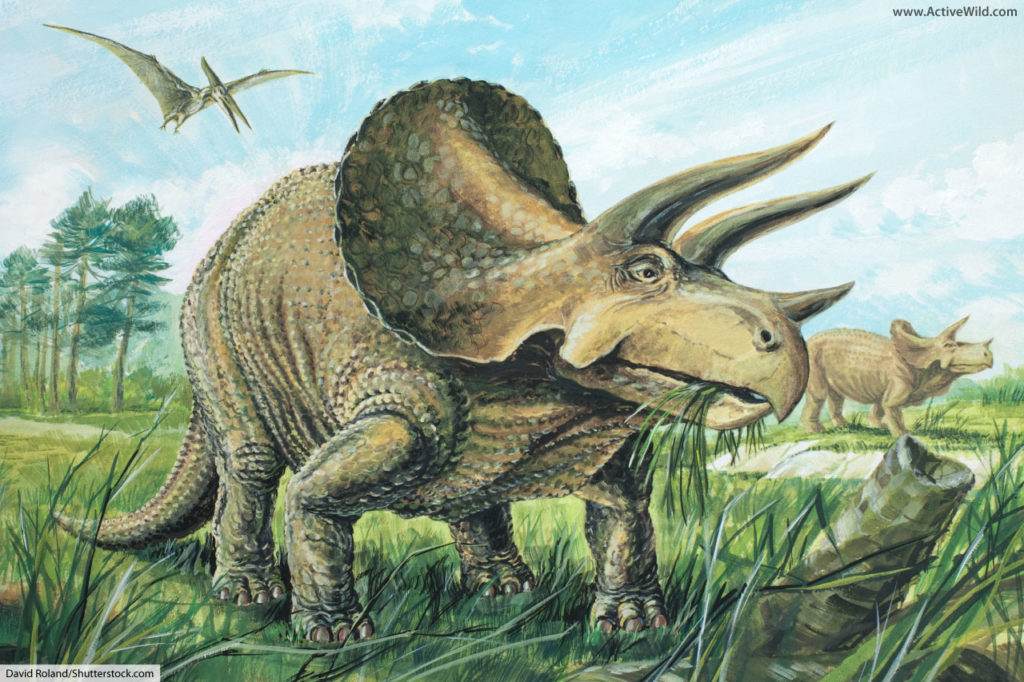
- Type of dinosaur: Herbivorous ceratopsian
- Period: Late Cretaceous
- Where found: North America
- Length: Approximately 8-9 meters (26-30 feet)
Triceratops' name means 'three-horned face'. This fearsome-looking herbivore was found in western America during the late Cretaceous Period. It may have lived in herds.
Triceratops was a large, heavily built dinosaur. It would have been able to put up quite a fight if attacked by meat-eaters such as Tyrannosaurus or Albertosaurus.
- You can find out more about Triceratops here: Triceratops Facts.
Troodon
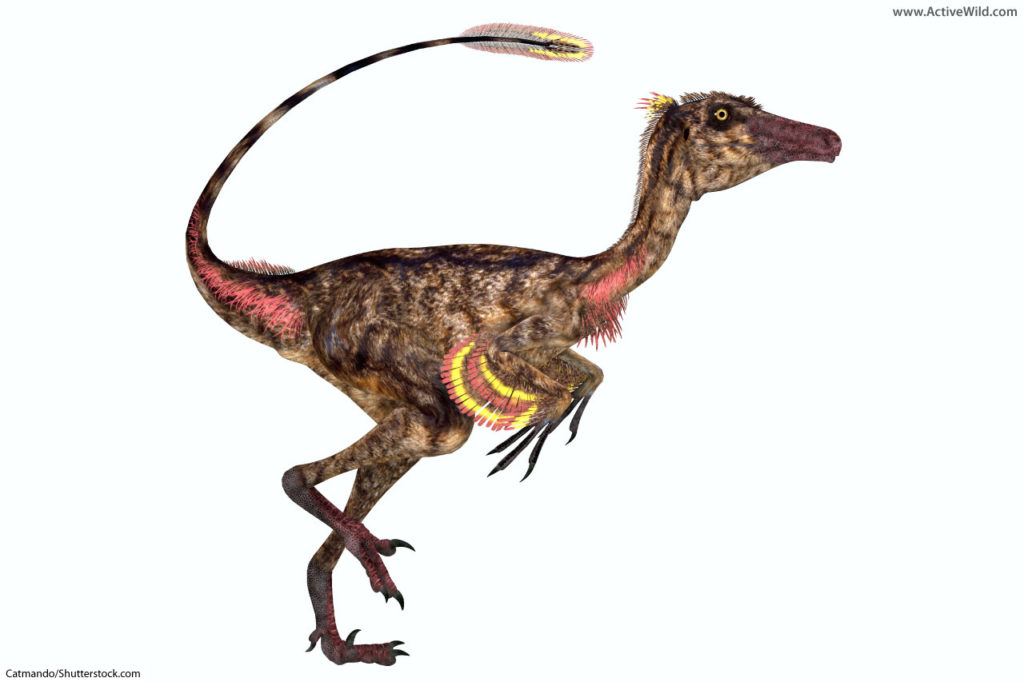
- Type of dinosaur: Theropod, dromaeosaurid
- Period: Late Cretaceous
- Where found: North America
- Length: About 2-2.4 meters (6.5-8 feet)
Troodon was a small, bird-like dinosaur of the Late Cretaceous Period. It grew to around 2 metres (6.5 ft.) in length, and would have stood waist-high to a man.
Despite its small size, troodon was well armed. It had sharp teeth, clawed fingers, and an enlarged, sickle-shaped claw on each of its feet. This intelligent dinosaur was fast, agile, and equipped with good eyesight.
- Find out more about Troodon here: Troodon Facts
Tyrannosaurus
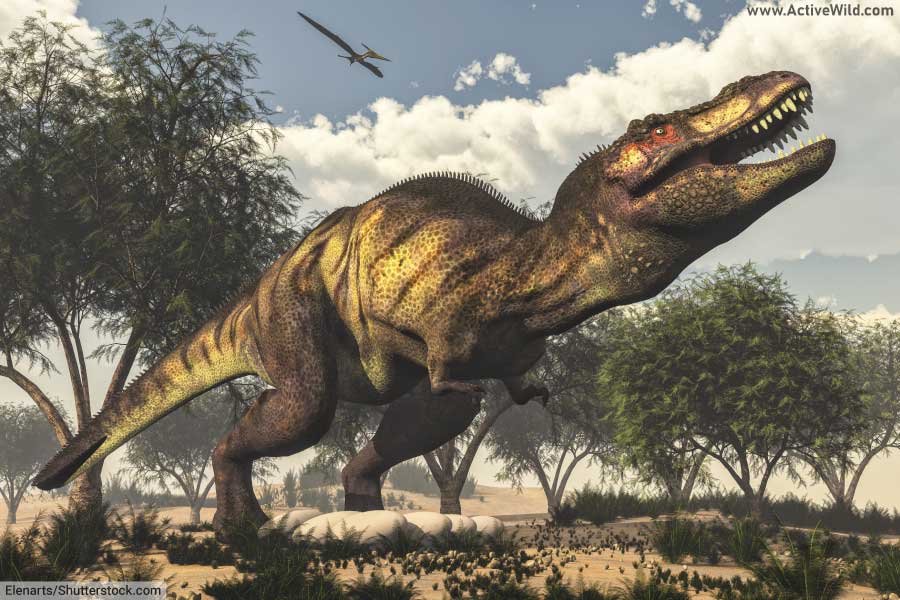
- Type of dinosaur: Theropod
- Period: Late Cretaceous (around 68-66 million years ago)
- Where found: North America
- Length: Up to 40 feet (12 meters)
Tyrannosaurus is perhaps the most famous type of dinosaur in the world, and no list of dinosaurs would be complete without it! One species in particular, Tyrannosaurus Rex, is particularly well-known as being the archetypal ‘killer dinosaur’.
Tyrannosaurus is one of the largest land-based meat-eaters of all time. Not only was it strong; it was also intelligent, fast, and equipped with excellent senses of both sight and smell.
One feature of tyrannosaurus is its huge skull. The skull would have been able to support large jaw muscles, giving tyrannosaurus a powerful bite.
Tyrannosaurus grew to around 12 metres (40 ft.) in length, and weighed up to 8 metric tonnes (9 short tons). It lived right to the end of the Cretaceous Period, becoming extinct along with all of the other non-bird dinosaurs in the Cretaceous-Paleogene Extinction Event.
- You can find out more about Tyrannosaurus Rex on this page: Tyrannosaurus Rex Facts.
Utahraptor
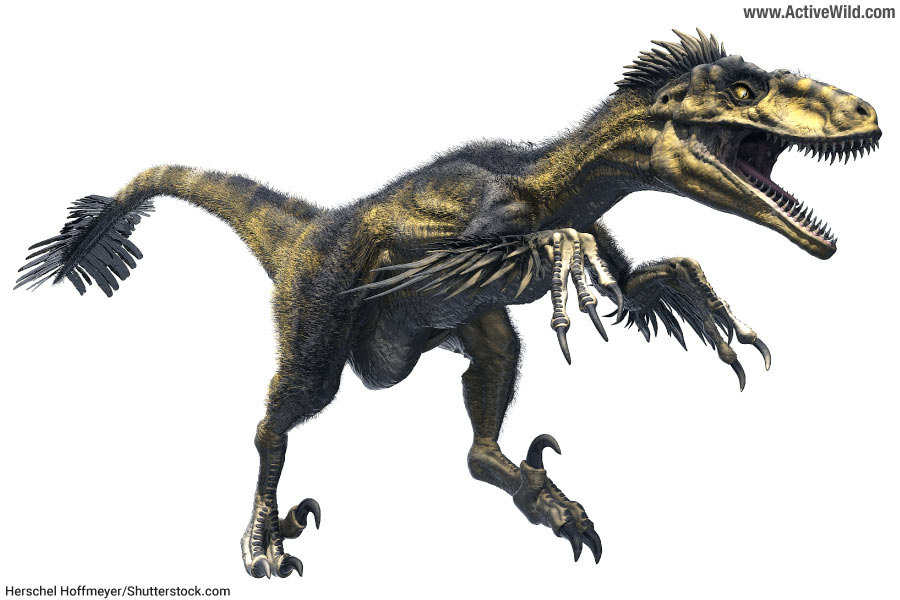
- Type of dinosaur: Dromaeosaurid
- Period: Early Cretaceous (around 124 million years ago)
- Where found: North America (Utah)
- Length: About 23 feet (7 meters)
As a member of the raptor family, Utahraptor was a carnivorous dinosaur characterized by a large sickle-shaped claw on each foot. It was much larger than other raptors like Velociraptor. It likely used its claw to pin down prey while delivering fatal bites with its sharp teeth.
Velociraptor
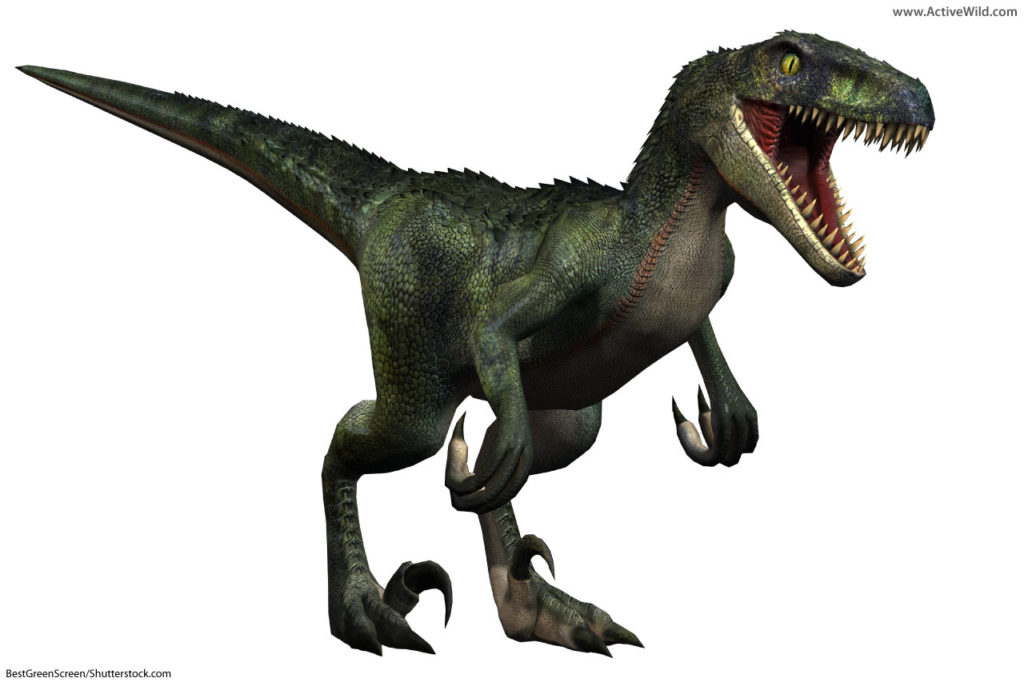
- Type of dinosaur: Theropod, dromaeosaurid
- Period: Late Cretaceous
- Where found: Mongolia and China
- Length: Approximately 2 meters (6.5 feet) from head to tail
Velociraptor was a small, bird-like, predatory dinosaur of the late Cretaceous Period. Its name–which means ‘swift plunderer’–accurately describes this speedy, fierce carnivore.
Velociraptor was armed with sharp teeth and sharp claws. Its most fearsome weapons were the large, curved inner claws on either foot. These were probably used not only for slashing and ripping, but also to grab and restrain the velociraptor's unfortunate prey.
The popular portrayal of Velociraptors in movies like "Jurassic Park" is not entirely accurate. In reality, they were much smaller than depicted and likely had feathers. The film's depiction is more reminiscent of a larger dromaeosaurid, such as Deinonychus or Utahraptor.
- You can find out more about Velociraptor here: Velociraptor Facts.
List of Dinosaurs – Dinosaur Names with Pictures: Conclusion
We hope that you enjoyed this list of dinosaurs. We'll be adding new dinosaurs regularly so be sure to check back soon!
What's your favorite dinosaur on the list? Have we missed any out? Were there any on the list that you hadn't heard of? Let us know in the comments at the bottom of the page!
Discover More Dinosaurs!
You can see more awesome dinosaurs on the following pages:
- Triassic Dinosaurs List with Pictures & Facts
- Jurassic Dinosaurs List with Pictures & Facts
- Cretaceous Dinosaurs List with Pictures & Facts
More Dino Information at Active Wild
- You can find more dinosaur information here: Dinosaur Facts
- Learn more about the different periods of the Mesozoic Era: Dinosaur Periods
- Discover the different types of dinosaurs: Types of Dinosaur

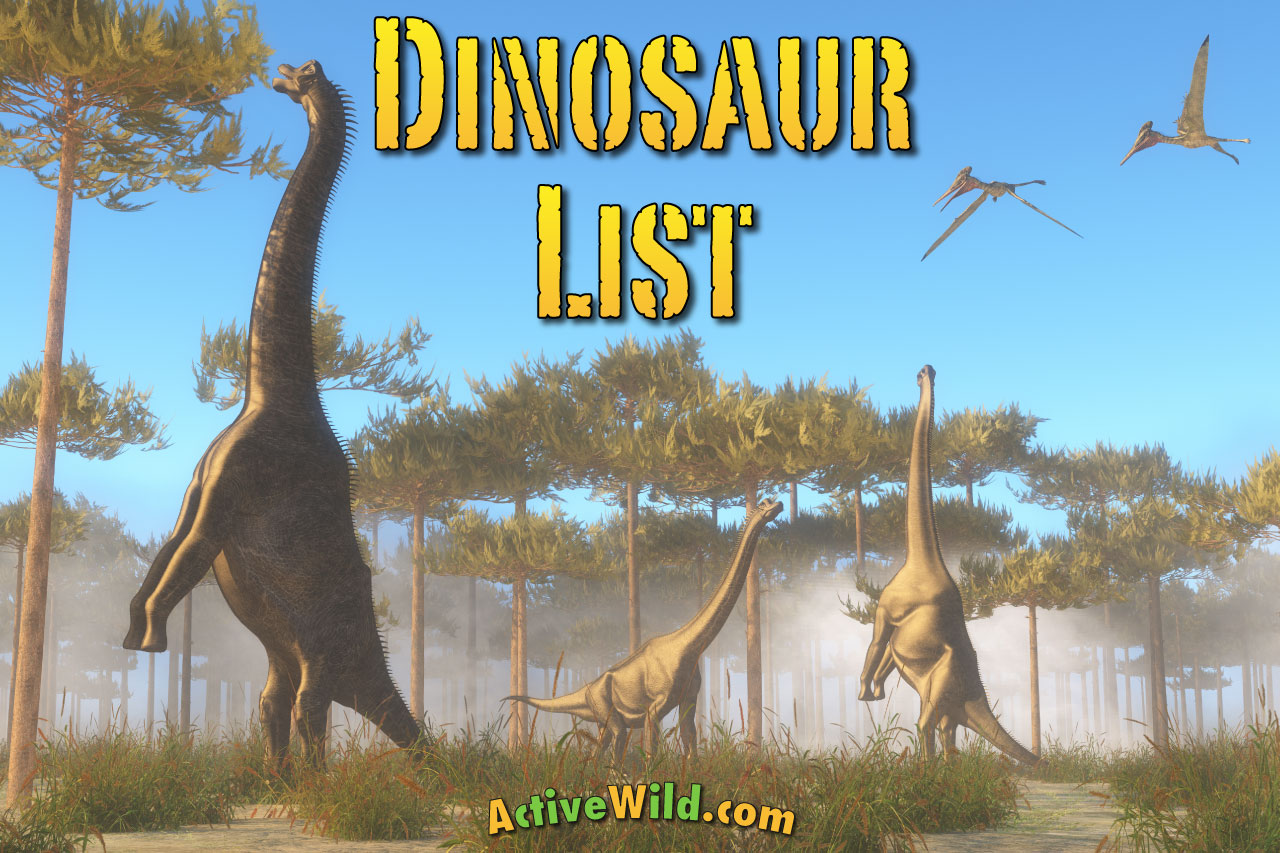

What about the microraptor, euoplocephalus, and yangchuanosaurus. I’m just thinking of other names. Also eustreptospondylus.
Do dinos walk on their front feet?
Good question,
Some dinosaurs (e.g. Albertosaurus and T. rex) were “bipedal”, meaning that they walked on their two (hind) legs. Some dinosaurs (e.g. Apatosaurus and Brachiosaurus) were “quadrupedal”, meaning they walked on all four legs, and others (e.g. Edmontosaurus and Iguanodon are thought to have alternated between walking on two and four legs, depending on whether they were walking, running, browsing, grazing, etc.
The Active Wild Team
the spinosaurus on the picture should have a more fish-like tail.
Learning the total list.
Why giganotasaurus is not the king of dinosaurs ?
Gigga is smaller and weaker then the trex. Dunno why Ark has it as the strongest dinosaur.
Giganotosaurus is actually bigger than the t-rex. It’s one of the biggest carnivores that ever lived.
How are the ichthyosaurs classified? I guess they diverged before the archosaurs evolved, and then the dinosaurs branched off from them. I live in Nevada, and we have a state park devoted to their fossils.
Great question!
The early evolution of the ichthyosaurs is quite cloudy but yes, what you say does seem to be the case.
The early ancestors of ichthyosaurs probably branched off from other diapsid reptiles in the early Triassic, before the emergence of the archosaurs.
The dinosaurs then evolved from the archosaur branch (not from the Ichthyosaur branch, which became extinct in the Cretaceous).
We assume you mean the Berlin-Ichthyosaur State Park? It sounds a fascinating area and we would love to visit it one day!
Regards,
The Active Wild Team
Lirainosaurus , ichthyosaurs, brontosaurs, silvisaurus some dinosaurs you forgot
Fact:
Stegosaurus pump blood into their plates and it goes different colours and also it is used to scare other predators away.
Fact:
Ankylosaurus’ tail can break a T. rex’s bones in 1 swipe
What about cryolophosaurus I heard about this on dinosaur king plz can give me a description of what it looks like and facts about it thx
crest on back of head and about the same size of a carnotaurus lived in jurassic period.
Cryolophosaurus lived in Antarctica. At least that’s what I heard. All I know is that it lives in a cold place. It might be covered in feathers.
… that’s correct. Cryolophosaurus, an early Jurassic theropod, was found in what is now Antarctica. 👍
why you don’t add dinosaur like Therizinosaurus,velociraptor and maiasaura
i forgot to add utahraptor
others that should be here
stigmyloch
pachycephalausaurus
argentinosaurus
mosasaurus
dimetrodon
pteranodon
pterodactyl
camarasaurus
kentosaurus
amarasaurus
dilophosaurus
INDOMINUS REX
INDORAPTOR
elasmosaurus
styracosaurus
Fun fact, pterodactyls aren’t actually dinosaurs.
indominus rex is made up and its not real dimetrodon appeared in the paleozoic era not the mesozoic its not a dinosaur and half of ur list arent even dinosaurs although they do appear in mesozoic era
Triceratops is not in the list
Pachycephalosaurus should be on the list.
The gigantosaurus is bigger than the spino by far it was like x2 bigger than it
You should add stuff like Therizinosaurus and Deinocheirus and Erlikasaurus. You could also add Ostafrikasaurus and Irriator and more.
I’d love to see Microraptor, Eustreptospondylus, Majungasaurus, Carcharodontosaurus and Argentinosaurus.
Never heard of
Chunkingosaurous
Hyayangosayrous
Struthiomimus
Camarasauros
Metriacantyosaurus
Crichtonsaurus
I am a bit of a Dino nerd I know quite a bit about dinos but not them names thx
Hi . Could you please add these prehistoric reptiles? (Acanthostegha,Panderichthys,Gorgonichys)
Great suggestions (we’ve never even heard of #3!). They’re not dinosaurs, so we may add them to a prehistoric animals page in the future.
Thanks again 🙂
Sorry to be that guy but…. In your article of Carnotaurus you say it is the only horned theropod, this is inaccurate. Ceratosaurus was a horned as well. On that note I love that you describe Carnotaurus as being agile and an exceptional hunter. I have read other articles that say the meat eating bull was a slow scavenger. Looking at the skeleton you can definitely tell this creature could run fast and be agile.
Hi Chad,
No need to apologize, we appreciate your comment. You’re quite correct; Ceratosaurus did indeed have horns (the genus name even means ‘horned lizard’). We’ve amended the Carnotaurus page accordingly.
Regards,
The Active Wild Team
Maybe cynodont too. And dimorphodon. Quezalcoatlus, ornithcheirus, tapejara.
I wonder is there a specific site that has a lot of dinosaurs i have been to zoom it is awesome but i need more I would love to see new ones. i have 7 books but a lot of the dinosaurs are multiple . I heard there were new dinosaurs i am not sure but i think China .i am kind of addicted but i wish some of them would of survived .
Hi Sheila,
Check out these pages: Triassic Dinosaurs, Jurassic Dinosaurs and Cretaceous Dinosaurs for more dinos!
Why their name end with sauras what does it mean
Hi,
Good question. ‘Saurus’ comes from ancient Greek and means ‘lizard’ or ‘reptile’.
Love your animals and facts sheets. Our staff provide 14 supported playgroups across Canterbury Bankstown NSW and teach children and parents about animals and many more topics. Would love your newsletter. Love science and exposing children to a significant area.
Regards,
Marg. Family Worker/Team leader
Thank you for your comment, much appreciated!
All the best to you, your staff and pupils 🙂
Regards,
The Active Wild Team
P.S. If there’s anything that we can do to improve the site / worksheets then we’re all ears. Let us know via our contact page.
I would love to see these dinosaurs included:
– chungkingosaurus
– huayangosaurus
– gallimimus
– struthiomimus
– camarasaurus
– majungasaurus
– ceratosaurus
– metriacanthosaurus
– crichtonsaurus
and more!
Wow, what a great list! We’re impressed!
You’ll find a few of them on our Jurassic and Cretaceous dino pages, but we’ll try to include all of them eventually.
Thank you for your excellent suggestions.
Thank you! I hadn’t seen the other pages, I’ll check them out!
hey so you know how their are like 700 species of dinos, i know somewhere out their, there is like 5,000 more to find. we aren’t looking in the right places. i have been studying dinos since i first learned about them which was ten years ago when i was five. you should add all of them well most of them. some i dont know others i have known for a while.
Sincerely,
Dom, 15 year old from PA
Hi Dom,
Thank you for your comment. It’s good to hear from a young paleontologist. Perhaps one day we’ll add all of them!
Where are all the other dinos?
Hi,
See our reply to Kirsten’s comment above! 🙂
What is the name of the bird pictured with the Triceratops? There is no information given on this.
Hi,
Thank you for your comment, well spotted!
It’s actually a pterosaur – a flying reptile – rather than a bird.
The actual species isn’t given. However, judging by the crest we think it may be a member of the family Pteranodontidae, which, like Triceratops, were around in North America in the Late Cretaceous period.
We hope this helps!
Regards,
The Active Wild team.
you should add all dinos
Hi, thank you for your comment.
We’d love to add all the dinosaurs, but the Mesozoic Era lasted around 180 million years – that’s a lot of dinosaurs!
We’re always adding new dinosaurs to this list, and to other pages on Active Wild.
Check out these pages to see even more dinos:
Triassic Dinosaurs
Jurassic Dinosaurs
Cretaceous Dinosaurs
You prob shouldn’t bec there are about 700 hundred species of dinosaurs. That’s too much.
thanks for the help im 10 yr old filipino girl tthat i like the movie jurrasic world now im taking notes about dinasaurs i learned a lot your AWESOME
… thank you for your comment, it’s good to hear from a fellow dinosaur fan! 🙂
Compsognathus was one of the smallest dinosaurs. I think it should be on the list.
Good call, we’re on it!
Acanthostega is an amphibian, not a reptile. And by the endings of the other two, I don’t know who hat they are, they seem like fish, again not a reptile.
good idea and a micro raptor
How do you find the dinosaurs bone,s?
Dinosaur bones are found in numerous ways. Sometimes the fossilized remains are found by mistake – for example when foundations for new buildings are being excavated.
Other times, paleontologists organize “digs” in known fossil-holding areas.
There are several “dinosaur hotspots” around the world with the right geological characteristics for the preservation of dinosaur remains.
The Active Wild Team